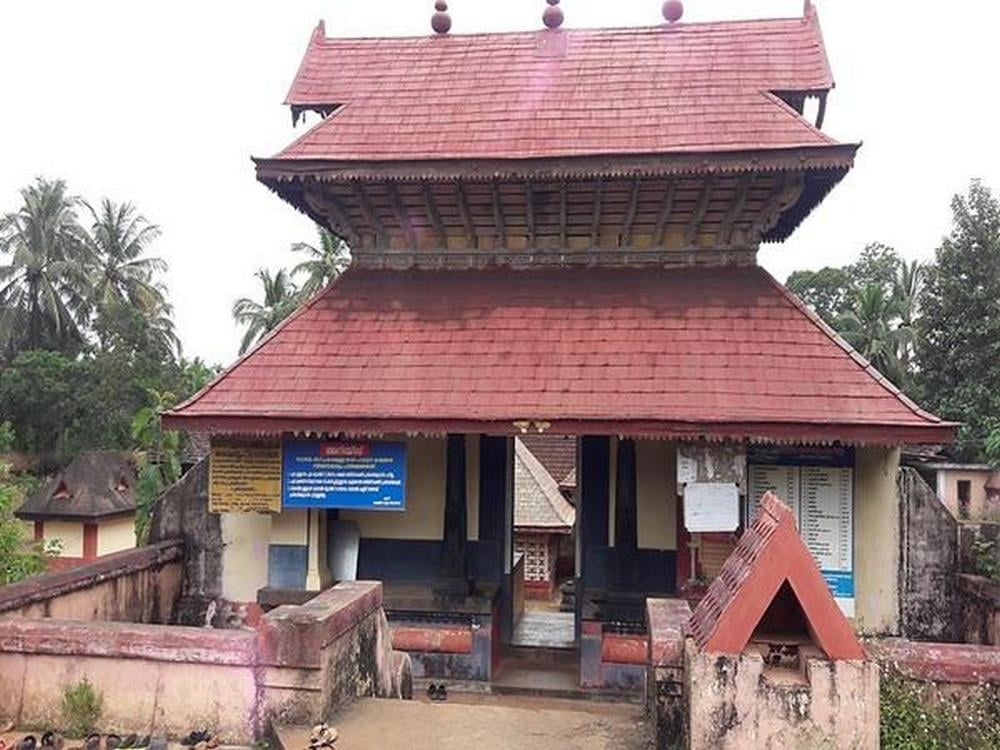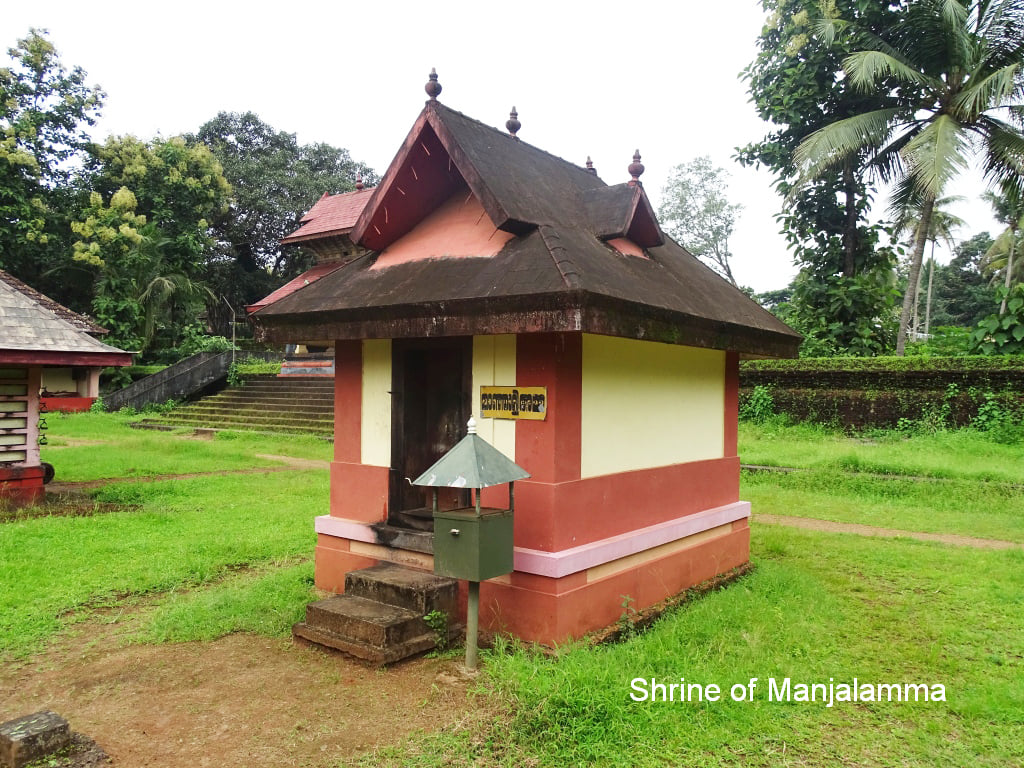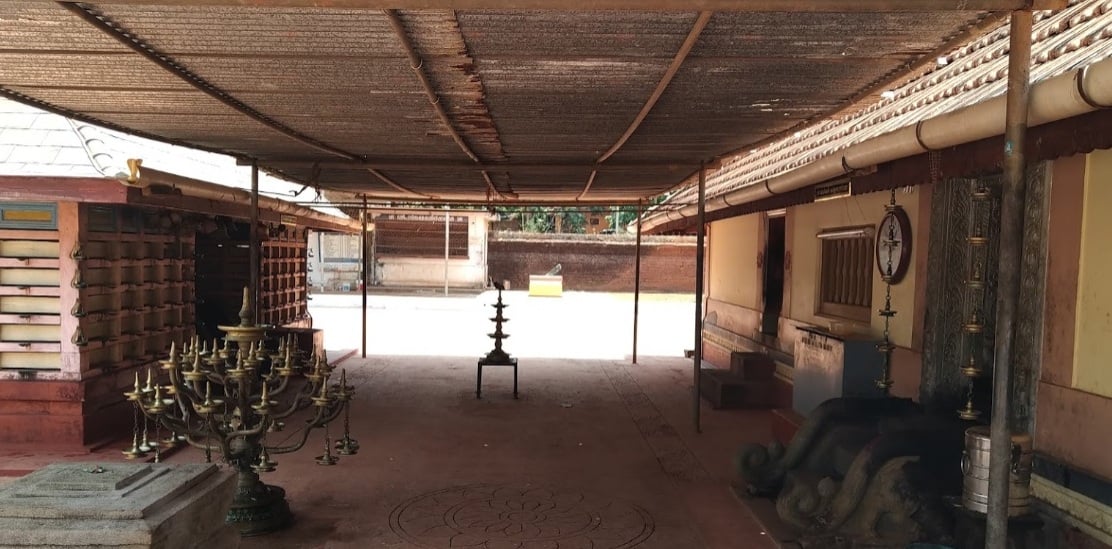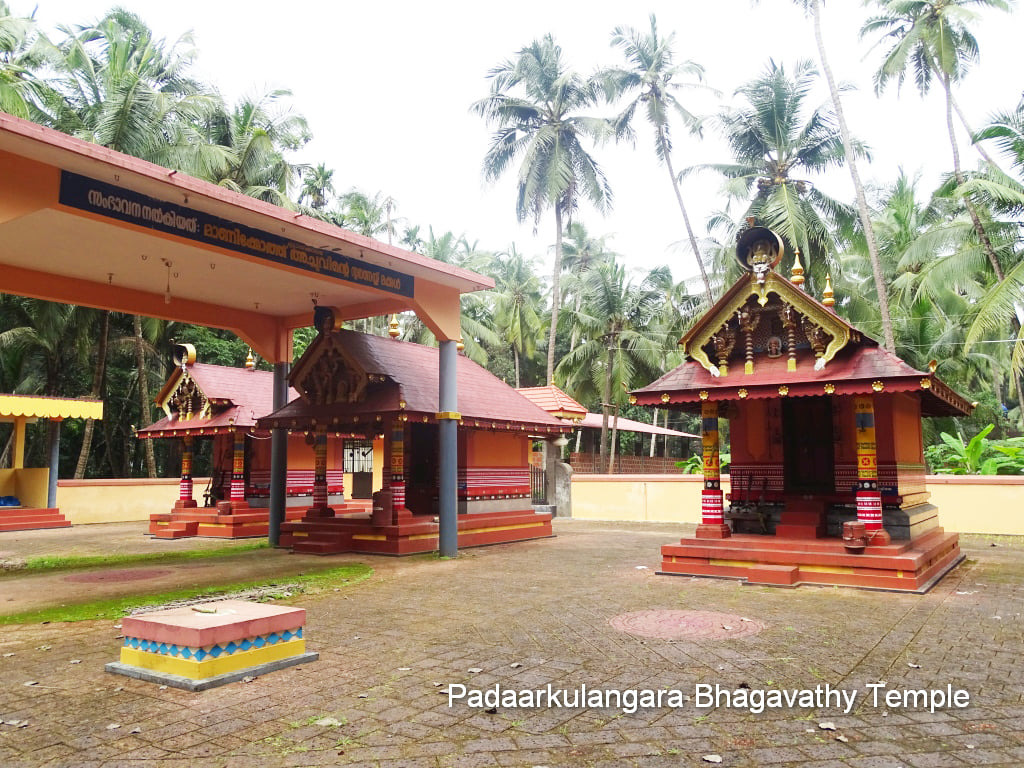Sree Madiyan Koolom Temple, located near Kanhangad in Kerala, is one of the most revered Hindu temples in Kasaragod district, with a history spanning over 500 years.

Sree Madiyan Koolom Temple is dedicated to Kshetrapalakan Eswaran and the fierce mother goddess Kalarathri Amma (Bhadrakali).
As one of North Kerala’s oldest temples, Madiyan Koolom serves as the spiritual headquarters of Allada Swaroopam Mookatham Nadu. Renowned for its ancient wooden carvings and epic poems, the temple reflects a rich tradition that embraces the unity of different religions and castes. A unique ritual practice here is that while a Brahmin priest performs pooja at noon, the morning and evening poojas are conducted by a sect called Maniyanis.
According to legend, Kshetrapalakan Eswaran traveled from Udinur along with Vairajathan in search of a sacred space to reside. Upon reaching Madiyan, he was drawn to the divine fragrance of Appam being prepared as an offering for Nadayil Bhagavathi, the temple’s presiding deity at the time. Observing his reluctance to continue the journey, Sastha and his accompanying disciples called him "Madiyan Thampuran"—where Madiyan translates to “lazy” in Malayalam. This name later evolved into Madiyan Kshetrapalakan.
Inside the temple, the Daru Shilpam (wooden sculpted ceiling) is a significant architectural feature, showcasing exquisite craftsmanship.
Another intriguing aspect of the temple’s history is that Kshetrapalakan Thampuran eventually chose to rest on the lap of Kalarathri Amma, who was in her Ugra Roopam (fierce form), finding solace in her maternal love and care. This act led to the belief that the name Madiyan also originates from Madi (lap) in Malayalam. This marked the end of the Shakteya Pooja (a form of worship associated with fierce Tantric rituals) previously performed at the temple. As a symbolic remembrance of those traditions, Kallu (palm toddy) and fish are still ceremonially brought into the temple during the Kalasham festival. The origins of Sri Madiyan Kovilakam are deeply rooted in devotional stories and historical significance. One of the temple's remarkable aspects is that it allowed entry for lower-caste people long before the Temple Entry Proclamation in Kerala, making it a symbol of inclusivity and religious harmony.
The temple is dedicated to Kshethrapalakan Eswaran, who is revered as a divine protector and a representation of religious unity. Two major festivals, the Paattu Mahotsavam in the Malayalam month of Dhanu and the Kalasham festival in Edavam, are celebrated with great fervor. These festivals stand as a testament to the temple's tradition of communal harmony, where people from different castes and communities, including Hindus and Muslims, come together in devotion. The temple is also an important symbol of Hindu-Muslim unity in the region.
It is believed that the respect and devotion of the local Muslim community toward the temple played a role in allowing the site of an Athiyal temple to be converted into the first mosque in the region.According to legend, Kshethrapalakan Eswaran descended to earth under the command of Lord Mahadeva to conquer Allada Swaroopam, a kingdom stretching from the Chittari River in the north to the Olavara River in the south.
During that period, kingdoms were often named Swaroopam. Allada Swaroopam was ruled by a cruel and oppressive lord known as Allohalan.
Meanwhile, Kerala Varma, the son of the Kolathiri dynasty, fell in love with Pankipillayathiri Thamburatti of Nediyirippu Swaroopam. Despite strong opposition, they married and aspired to establish their own kingdom for their descendants. To achieve this, they set out to conquer Allohalan's territory. Kerala Varma successfully breached the fortress and took control of the kingdom. He later worshipped Kshethrapalakan Eswaran and Kalarathri Amma in gratitude for their divine assistance in his conquest.
However, the people around him remained loyal to Allohalan, posing a challenge to his rule.
To secure his reign, he appointed Moolchary Nairachan as the temple custodian and established a palace in Nileshwaram, ruling alongside his queen.
Traditionally, an outer Kalasham ceremony was conducted on the 2nd of Edavam to honor Nadayil Bhagavathi through the ritual art form of Theyyam, alongside worship of Kshethrapalakan Eswaran and Kalarathri Amma. This festival is considered complete only when all the people of the land participate, a tradition that continues to this day.
Even today, Madiyan Koolom remains the spiritual and cultural headquarters of Allada Nadu, preserving its legacy of devotion, inclusivity, and regional unity.
Sri Madiyan Koolom Temple spans approximately 2.4 hectares (6 acres), with half of its area comprising traditional Kerala-style monuments. The temple is renowned for its exquisite sculptures and wooden carvings, which depict ancient stories from the Ramayana and other epics.
Most of these intricate carvings can be found in the Thekkini, the western Gopuram, and the Mandapa near the temple pond. The Thekkini Mandapam, located near the temple kitchen, features artistic representations of Dakshayagam, Seetha Swayamvaram, and the Vanayathra (forest journey) of Rama and Lakshmana.
However, due to prolonged exposure to smoke from the temple kitchen, many of these wooden etchings have been partially or completely destroyed. Despite media reports highlighting this issue, no significant restoration efforts have been undertaken by the authorities.Similarly, the wooden carvings depicting the twelve Raashis (zodiac signs) and the Navagraha Devatas (nine planetary deities) at the Gopuram pond have suffered damage due to being painted over with silver.
The western Gopuram showcases magnificent depictions of Amruthamadhanam (churning of the ocean), Kaliyamardhanam (Krishna subduing the serpent Kaliya), and Ananthashayanam (Vishnu reclining on Ananta, the serpent).
The artwork illustrating the churning of the ocean stands out for its extraordinary beauty. The temple also features erotic wooden carvings akin to those found in the Khajuraho temples of Madhya Pradesh. Additionally, mythical figures such as elephants with feathers are uniquely represented in the temple’s artwork.
The carvings are further enhanced by the use of natural colors derived from rare plants and trees, adding to their aesthetic appeal. A significant mural painting of Narasimha Avatar (the half-lion, half-human incarnation of Vishnu) is another attraction within the temple.
The temple also houses two ponds, each with its own legends. Near the entrance, there is a small sculpture of a bowing elephant, believed to place a curse on any elephant attempting to enter the temple, as elephants are strictly prohibited inside. Additionally, a sculpture of a snake within one of the ponds is associated with a local legend—according to belief, the snake was sent to poison the pond, leading to its petrification as a curse.
മടിയൻ കൂലോം ക്ഷേത്രം
മടിയൻ കൂലോം ക്ഷേത്രം കാസർഗോഡ് ജില്ലയിലെ അജാനൂർ ഗ്രാമപഞ്ചായത്തിലെ മടിയൻ പ്രദേശത്ത് സ്ഥിതിചെയ്യുന്നു, കാഞ്ഞങ്ങാടിൽ നിന്ന് ഏകദേശം അഞ്ച് കിലോമീറ്റർ അകലെയായാണ് ഇതിന്റെ സ്ഥാനം. ഭദ്രകാളി ദേവിയായ കാളരാത്രിഅമ്മയാണ് പ്രധാന പ്രതിഷ്ഠ, കൂടാതെ ക്ഷേത്രപാലകൻ, ഭഗവതി, ഭൈരവൻ എന്നിവയും ആരാധനമൂർത്തികളായി കിരീടിതരിച്ചിരിക്കുന്നു. ഇവിടെ ഉഷഃപൂജയും സന്ധ്യാപൂജയും മണിയാണികൾ (യാദവർ) നിർവഹിക്കുമ്പോൾ ഉച്ചപൂജ ബ്രാഹ്മണർ നടത്തുന്നു.
ഇടവ മാസത്തിലെ കലശവും ധനു മാസത്തിലെ പാട്ടുൽസവവുമാണ് പ്രധാന ഉത്സവങ്ങൾ. കൂടാതെ തണ്ണീലാമൃതം, ഉദയസ്തമന പൂജ എന്നിവ ഉൾപ്പെടെയുള്ള വഴിപാടുകൾ ഇവിടെ പ്രസിദ്ധമാണ്. 6 ഏക്കറോളം വിസ്തീർണ്ണത്തിലുള്ള മടിയൻ കൂലോം ക്ഷേത്രം 3 ഏക്കറോളം സ്ഥലത്ത് പരമ്പരാഗത കേരള ശൈലിയിലുള്ള വാസ്തുവിദ്യയിൽ നിർമിച്ചിട്ടുള്ളതാണ്. ഈ ക്ഷേത്രം അതിസുന്ദരമായ ശില്പങ്ങളും അപൂർവ ദാരു ശിൽപ്പങ്ങളും കൊണ്ട് പ്രശസ്തമാണ്, എന്നാൽ പലതും നാശത്തിന്റെ വക്കിലാണ്. രാമായണത്തെയും മറ്റു ഇതിഹാസങ്ങളെയും ആസ്പദമാക്കി നടത്തിയ തടി കൊത്തുപണികൾ പ്രധാനമായും തെക്കിനി, പടിഞ്ഞാറൻ ഗോപുരം, കുളത്തിനടുത്തുള്ള മണ്ഡപം എന്നിവിടങ്ങളിലാണുള്ളത്.
അടുക്കളയ്ക്ക് സമീപമുള്ള തെക്കിനി മണ്ഡപത്തിലെ ദക്ഷയാഗം, സീതാ സ്വയംവരം, രാമ-ലക്ഷ്മണന്മാരുടെ വനയാത്ര എന്നിവയുടെ കൊത്തുപണികൾ കാലക്രമേണ പുകയുടെയും കരിയുടെയും ആഘാതത്തിൽ നശിക്കുകയാണ്. കുളത്തിലെ ഗോപുരത്തിൽ 12 രാശികളും നവഗ്രഹ ദേവതകളുടെയും ദാരു ശിൽപ്പങ്ങളും വെള്ളിപ്പൊട്ട് പുരട്ടി നശിപ്പിക്കപ്പെട്ടിരിക്കുന്നു. പടിഞ്ഞാറൻ ഗോപുരത്തിൽ അമൃതമഥനം, കാളിയമർദ്ദനം, അനന്തശയനം എന്നിവയുടെ മനോഹരമായ ദാരു ശിൽപ്പങ്ങളുണ്ട്, പ്രത്യേകിച്ച് പാലാഴി കടത്തലിന്റെ ദൃശ്യങ്ങൾ അതുല്യ സൗന്ദര്യമുള്ളവയാണ്. ഖജുരാഹോ ക്ഷേത്രത്തിൽ കണ്ടുവരുന്ന രതി വർണ്ണനകളും ഇവിടെ ദാരു ശില്പങ്ങളിലുണ്ട്.
പുരാവസ്തു വകുപ്പ് ക്ഷേത്ര സംരക്ഷണത്തിനായി കൈകടത്തുന്നതായി റിപ്പോർട്ടുകളുണ്ട്. സഞ്ചാരികൾക്ക് ആവേശം പകരുന്ന ഈ കൊത്തുപണികൾ തനതായ സസ്യങ്ങളിൽ നിന്നുമുള്ള പ്രകൃതിദത്ത നിറങ്ങൾ ഉപയോഗിച്ച് ചിതറിച്ചിട്ടുള്ളതാണ്. മഹാവിഷ്ണുവിന്റെ നരസിംഹാവതാരത്തെ പ്രതിനിധീകരിക്കുന്ന ഒരു മനോഹര ചുവർ ചിത്രവും ഇവിടെയുള്ള ആകർഷണങ്ങളിൽ ഒന്നാണ്. ക്ഷേത്രത്തിൽ രണ്ട് കുളങ്ങളുണ്ട്, പ്രവേശന കവാടത്തിൽ കുനിയുന്ന ആനയുടെ ചെറിയ ശിൽപ്പവും കുളത്തിൽ പാമ്പിന്റെ ശില്പവുമുണ്ട്, ഇതിന് പിന്നിൽ പ്രാചീന വിശ്വാസങ്ങളുമുണ്ട്.



